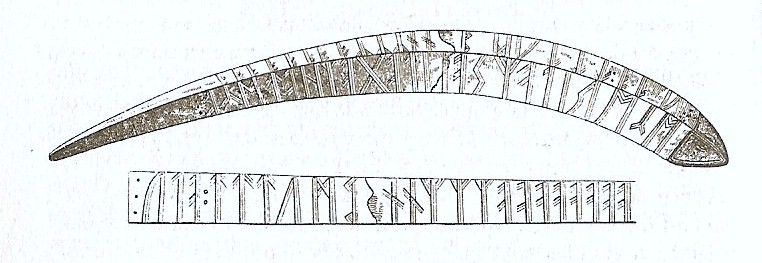|
Til árs Ok Friðar
("For a good year and peace") is an Old Norse ritual formula recorded in association with Old Nordic religion, Old Nordic religious practices such as drinking at blót-feasts and in the making of offerings at Howe (grave), howes, in particular in association with Freyr. While the phrase's origins are debated by scholars, it was likely adopted by the Church during the Christianisation of Scandinavia, leading to its inclusion in the Medieval Scandinavian law codes ''Gutalagen'' from Gotland and ''Den ældre Gulathings-Lov'' from Norway. Its usage its very similar in both heathen and Christian contexts, in which figures relevant to each religion are appealed to in order to bring a good year and peace, typically by a societal elite. Meaning and etymology and its related forms have been variously translated as "for good harvest and peace", "for prosperity and peace", "for good crops and peace" and "for a good year and peace". The phrase contains the words ("year", "plenty", "fruit ... [...More Info...] [...Related Items...] OR: [Wikipedia] [Google] [Baidu] |
AM 45 Fol
Codex Frisianus or Fríssbók (shelfmark AM 45 fol. in the Arnamagnæanske samling) is a manuscript of the early fourteenth century (c. 1300–1325). Among its 124 folios, it contains ''Heimskringla'' (without the Saga of Saint Olaf) and ''Hákonar saga Hákonarsonar''. Origins and history The manuscript might have been written in Iceland and soon moved into Norway or have been composed in Norway.Hollander, Lee M., ''Snorri Sturluson. Heimskringla: history of the kings of Norway'' (Austin: University of Texas Press for the American-Scandinavian Foundation, 2005), p. xxiv. It was found in Bergen in 1550 and brought to Denmark before 1600, when it was acquired by the collector Otto Friis, from whom it takes its name. It then came into the possession of Jens Rosenkrantz before being bought in 1695 by Árni Magnússon. The latter gave it at his death (1730) to the University of Copenhagen. Facsimiles and transcriptions * ''Codex Frisianus: (Sagas of the kings of Norway): MS. no. 45 f ... [...More Info...] [...Related Items...] OR: [Wikipedia] [Google] [Baidu] |
Anders Hultgård
Anders Hultgård (born 23 December 1936) is a Swedish theologist and religious studies scholar who is Professor Emeritus and former Chair of Religious History at Uppsala University. He specializes in the study of Indo-European religions. Biography Anders Hultgård was born in Stettin, Germany on 23 December 1936, the son of Nils Hultgård och Britta Paulsson. His father was Vicar of Norrköping. After graduating from high school, Hultgård served in the Swedish Army. He subsequently studied German, French and Greek literature at Uppsala University. After gaining an MA in these subjects in 1961, Hultgård studied theology, gaining a PhD in religious studies under the supervision of Geo Widengren in 1971. His dissertation examined the eschatology of the Testaments of the Twelve Patriarchs. He was ordained as a clergyman in the Church of Sweden in Linköping in 1973. He gained his habilitation on the history of religion in 1975. He subsequently lectured at Uppsala until 1985. In 19 ... [...More Info...] [...Related Items...] OR: [Wikipedia] [Google] [Baidu] |
Óðinn
Odin (; from ) is a widely revered god in Norse mythology and Germanic paganism. Most surviving information on Odin comes from Norse mythology, but he figures prominently in the recorded history of Northern Europe. This includes the Roman Empire's partial occupation of Germania ( BCE), the Migration Period (4th–6th centuries CE) and the Viking Age (8th–11th centuries CE). Consequently, Odin has hundreds of names and titles. Several of these stem from the reconstructed Proto-Germanic theonym ''Wōðanaz'', meaning "lord of frenzy" or "leader of the possessed", which may relate to the god's strong association with poetry. Most mythological stories about Odin survive from the 13th-century ''Prose Edda'' and an earlier collection of Old Norse poems, the ''Poetic Edda'', along with other Old Norse items like ''Ynglinga saga''. The ''Prose Edda'' and other sources depict Odin as the head of the pantheon, sometimes called the Æsir, and bearing a spear and a ring. Wider so ... [...More Info...] [...Related Items...] OR: [Wikipedia] [Google] [Baidu] |
Toast (honor)
A toast is a ritual during which a drink is taken as an expression of honor or goodwill. The term may be applied to the person or thing so honored, the drink taken, or the verbal expression accompanying the drink. Thus, a person could be "the toast of the evening", for whom someone "proposes a toast" to congratulate and for whom a third person "toasts" in agreement. The ritual forms the basis of the literary and performance genre, of which Mark Twain's "To the Babies" is a well-known example. The toast as described in this article is rooted in Western culture, but certain cultures outside that Cultural area, sphere have their own traditions in which consuming a drink is connected with ideas of celebration and honor. While the physical and verbal ritual of the toast may be elaborate and formal, merely raising one's glass towards someone or something or clinking glasses with someone else's and then drinking is essentially a toast as well, the message being one of goodwill towards the ... [...More Info...] [...Related Items...] OR: [Wikipedia] [Google] [Baidu] |
Trøndelag
Trøndelag (; or is a county and coextensive with the Trøndelag region (also known as ''Midt-Norge'' or ''Midt-Noreg,'' "Mid-Norway") in the central part of Norway. It was created in 1687, then named Trondhjem County (); in 1804 the county was split into Nord-Trøndelag and Sør-Trøndelag by the King of Denmark-Norway. After over two centuries of separation, in 2018 they were reunited following a referendum held two years earlier. The largest city in Trøndelag is the city of Trondheim. The administrative centre is Steinkjer, while Trondheim functions as the office of the county mayor. Both cities serve the office of the county governor; however, Steinkjer houses the main functions. Trøndelag county and the neighbouring Møre og Romsdal county together form what is known as Central Norway. A person from Trøndelag is called a ''trønder''. The dialect spoken in the area, trøndersk, is characterized by dropping out most vowel endings; see apocope. Trøndelag is one ... [...More Info...] [...Related Items...] OR: [Wikipedia] [Google] [Baidu] |
Heimskringla
() is the best known of the Old Norse kings' sagas. It was written in Old Norse in Iceland. While authorship of ''Heimskringla'' is nowhere attributed, some scholars assume it is written by the Icelandic poet and historian Snorri Sturluson (1178/79–1241) 1230. The title was first used in the 17th century, derived from the first two words of one of the manuscripts (''kringla heimsins'', "the circle of the world"). is a collection of sagas about Swedish and Norwegian kings, beginning with the saga of the legendary Swedish dynasty of the Ynglings, followed by accounts of historical Norwegian rulers from Harald Fairhair of the 9th century up to the death of the pretender Eystein Meyla in 1177. Some of the exact sources of ''Heimskringla'' are disputed, but they include earlier kings' sagas, such as Morkinskinna, Fagrskinna and the 12th-century Norwegian synoptic histories and oral traditions, notably many skaldic poems. The author or authors explicitly name the now lost w ... [...More Info...] [...Related Items...] OR: [Wikipedia] [Google] [Baidu] |
Ideographic Rune
Ideographic runes (, , 'term/notion runes') are runes used as ideographs instead of regular letters, that is, instead of representing their phoneme or syllable, they represent their name as a word or term. Such instances are sometimes referred to by way of the modern German loanword (singular ), but the descriptive term "ideographic runes" is also used. Ideographic runes appears to have mainly been used for saving space, but they were also mainly used without inflection. Some potential inscriptions might have used such cryptically. The criteria for the use of ideographic runes and the frequency of their use by ancient rune-writers remains controversial.See discussion in for example : 123–124 and : 17. The topic of has produced much discussion among runologists. Runologist Klaus Düwel has proposed two criteria for the identification of ideographic runes: A graphic argument and a semantic argument. Roman Iron Age (c. 1–350 AD) One of the earliest potential ideographic rune f ... [...More Info...] [...Related Items...] OR: [Wikipedia] [Google] [Baidu] |
Stentoften Stone
The Stentoften Runestone, listed in the Rundata catalog as DR 357, is a runestone which contains a curse in Proto-Norse that was discovered in Stentoften, Blekinge, Sweden. Inscription English translation provided by Rundata: Interpretation In lines AP and AQ, in the phrase "gaf j" ("gave j"), the j-rune is an ideographic rune that stands for the rune name *''jēra'', meaning "harvest" or "bountiful or fruitful year." One runologist suggests that line AQ is describing an animal sacrifice in return for a good harvest as part of a fertility ritual. History The Stentoften runestone was discovered in 1823 by the dean O. Hammer. It was lying down with the inscription facing downwards, surrounded by five sharp larger stones forming a pentagon or a pentagram. Consequently, the stone has been part of a larger monument like the Björketorp Runestone further east. In 1864, the runestone was moved into the church of Sölvesborg. Most scholars date the inscription to the 7th cen ... [...More Info...] [...Related Items...] OR: [Wikipedia] [Google] [Baidu] |
Indo-European
The Indo-European languages are a language family native to the northern Indian subcontinent, most of Europe, and the Iranian plateau with additional native branches found in regions such as Sri Lanka, the Maldives, parts of Central Asia (e.g., Tajikistan and Afghanistan), Armenia, and areas of southern India. Historically, Indo-European languages were also spoken in Anatolia. Some European languages of this family—English language, English, French language, French, Portuguese language, Portuguese, Russian language, Russian, Spanish language, Spanish, and Dutch language, Dutch—have expanded through colonialism in the modern period and are now spoken across several continents. The Indo-European family is divided into several branches or sub-families, including Albanian language, Albanian, Armenian language, Armenian, Balto-Slavic, Celtic languages, Celtic, Germanic languages, Germanic, Hellenic languages, Hellenic, Indo-Iranian languages, Indo-Iranian, and Italic languages, ... [...More Info...] [...Related Items...] OR: [Wikipedia] [Google] [Baidu] |
Yasht
A Yasht (, ) is a hymn of praise composed in the Young Avestan language and dedicated to specific Zoroastrian divinities. The term commonly applies to the collection of 21 Yashts, although it may also refer to other texts within the wider Avesta collection. Name The English word ''yasht'' is derived from Middle Persian 𐭩𐭱𐭲 (, "prayer, worship"). In the Pahlavi literature, the word is used interchangeably with ''yasn''. Yasht probably originated from Avestan 𐬫𐬀𐬱𐬙𐬀 (, "honored") from 𐬫𐬀𐬰 (, "to worship, honor"). It may ultimately go back to Proto-Indo-European ''*yeh₂ǵ-'' or ''*Hyaǵ-''. Avestan 𐬫𐬀𐬱𐬙𐬀 is also the origin of two other terms. First, Avestan 𐬫𐬀𐬯𐬥𐬀 (, act of worship), which is a general Zoroastrian term for an act of worship or specifically the Yasna ritual, and, second, Avestan 𐬫𐬀𐬰𐬀𐬙𐬀 (, (being) worthy of worship), which is a general Zoroastrian term for divinity. The ... [...More Info...] [...Related Items...] OR: [Wikipedia] [Google] [Baidu] |




